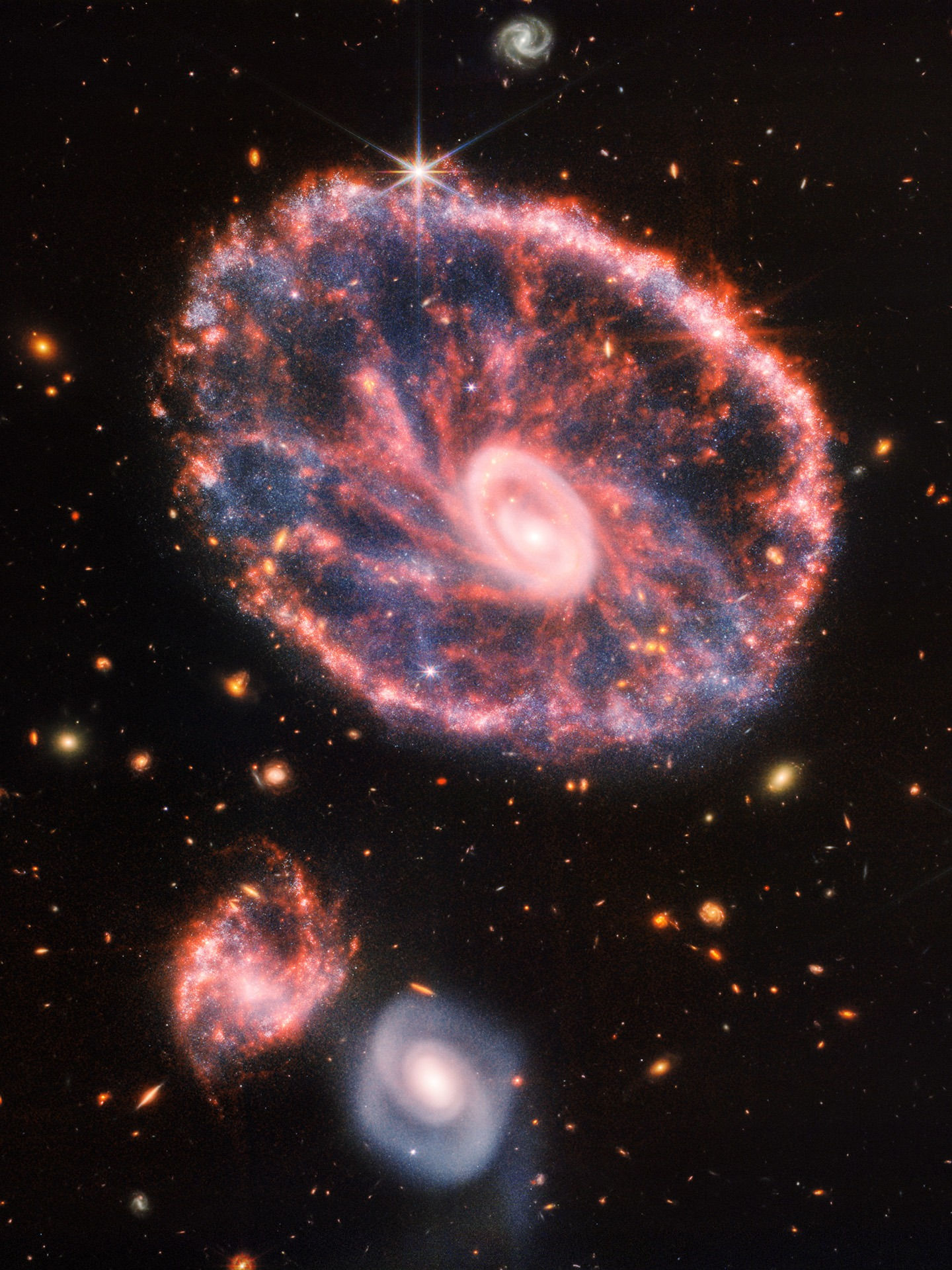Why our Big Bang is Part of a Multiverse?
- Phystroid
- Feb 15, 2023
- 7 min read
Updated: Feb 28, 2023
While the existence of the multiverse is still not experimentally verified, there exist strong theoretical hints for its existence. The most significant hint is the fine tuning of multiple key constants of nature.

Artistic representation of a multiverse. Our Big Bang might be a part of a much larger Universe.
The fine-tuning of the constants of nature is a fascinating topic that has captured the attention of many physicists, philosophers, and theologians. It refers to the fact that the values of certain physical constants, such as the strength of the electromagnetic and gravitational forces, the masses of elementary particles, and the cosmological constant, are remarkably "fine-tuned" to support the existence of life. If these constants had slightly different values, life as we know it would not be possible.
Below we provide some of the most important finely tuned parameters in our observable Universe.
Gravitational constant (G): If the strength of gravity were slightly stronger or weaker, planets and stars could not have formed. A weaker gravitational constant would result in a universe that is too diffuse, with no large structures such as galaxies, stars or planets.
The strength of the electromagnetic force: If the strength of the electromagnetic force were slightly stronger or weaker, the stability of atoms and molecules would be compromised. A stronger electromagnetic force would cause atomic nuclei to be unstable, while a weaker force would make it difficult for electrons to be captured by nuclei.
The strength of the weak nuclear force: If the strength of the weak nuclear force were slightly different, the fusion process in stars that creates heavy elements would not occur, making life as we know it impossible.

The couplings of the 4 forces of nature are finely tuned.
The strength of the strong nuclear force: If the strength of the strong nuclear force were slightly weaker, the stability of atomic nuclei would be compromised. The resulting unstable nuclei would not be able to form the heavy elements needed for life. The strong nuclear force that holds the atomic nucleus together is finely tuned to allow for the existence of carbon, which is a key element for the emergence of life.
Cosmological constant: If the value of the cosmological constant were even slightly different, the universe would either expand too quickly or collapse in on itself too quickly, making the formation of galaxies and stars impossible
The ratio of the mass of the proton to the mass of the electron: If this ratio were slightly different, chemical reactions would not be possible, as the properties of atoms and molecules would be too different.
The ratio of the strong nuclear force to the electromagnetic force: If this ratio were slightly different, stars would not be able to burn hydrogen into helium, which is the process that releases energy and sustains their stability.
The fine structure constant (alpha): This dimensionless constant determines the strength of the electromagnetic force and the size of atoms. If the fine structure constant were slightly different, the stability of atoms and the chemical reactions they take part in would be compromised.
The ratio of the neutron mass to the proton mass: If this ratio were slightly different, the stability of atomic nuclei would be compromised, making it difficult for heavy elements to form.
The Higgs boson mass: The Higgs boson is responsible for giving mass to elementary particles. If the Higgs boson mass were too high, particles would be too massive to form atoms and molecules, and if it were too low, particles would be too light to form stable matter.
The rate of expansion of the universe: If the universe were expanding too fast, galaxies and stars would not have had enough time to form, while if the universe were expanding too slowly, gravity would have caused it to collapse before life had a chance to emerge.
The initial conditions of the universe: The initial conditions of the universe determine the density of matter and the fluctuations that gave rise to the structures we observe today. If the initial conditions were slightly different, the universe would have expanded too quickly or too slowly, making the formation of galaxies and stars impossible.
The rate of nuclear reactions: The rate of nuclear reactions determines the amount of energy released in stars. If this rate were slightly different, stars would either burn out too quickly or not at all, making the formation of heavy elements and the existence of life as we know it impossible.
The way out of our apparent luck is to assume that the Universe is much larger than what we currently observe in space and/or in time. This could mean that there are multiple big bangs, with the vast majority of those Big Bangs being unable to support the existence of life, as the parameters that are fine tuned in our Universe would get random values in the other universes. It would be easy then to explain why our Big Bang appears to be finely tuned to accommodate life.
The Multiverse and Modern Physics

The Multiverse: Our Big Bang is just one of the many possible Big Bangs that have occurred and will occur in the Universe.
String theory is one of the leading frameworks for exploring the possibility of a multiverse. In string theory, the idea of a multiverse arises from the notion that there may be multiple "vacua" or stable solutions to the equations that describe the universe. Each vacuum could potentially correspond to a different universe with its own unique physical laws and properties. However, string theory not only remains untested, but is far from a complete theory and it's validity is based on quantum mechanics which is also a highly controversial theory with many different interpretations. Many physicists support the idea that quantum mechanics leads to a unreasonable explanation of nature and needs to be significantly modified.
Another idea related to the multiverse is the concept of eternal inflation, which suggests that our universe may be just one of many bubble universes that are constantly forming and expanding. According to this theory, the universe underwent a period of rapid inflation early in its history, and this process continues to create new universes in an ongoing cycle.
Of course this is a highly controversial idea which our website wouldn't support. While inflation is a well supported theory, the extension of the theory to include a Multiverse is a highly controversial theory.
An other highly debated theory that we can't support is the measurement problem in quantum mechanics: Some interpretations of quantum mechanics suggest that the act of measurement can create multiple parallel universes in which different outcomes of quantum events occur. However, this interpretation is highly controversial, and it is not clear whether it provides evidence for a multiverse or simply reflects the limitations of our current understanding of quantum mechanics.
Experimental Tests of A Multiverse
The cosmic microwave background (CMB) is a type of electromagnetic radiation that permeates the entire observable universe. It is thought to be a relic of the intense radiation that filled the universe in the early stages of its formation, shortly after the Big Bang. As the universe expanded and cooled, this radiation was redshifted to longer wavelengths, eventually becoming the microwave radiation that we observe today.
The CMB is one of the most important pieces of evidence in support of the Big Bang theory, as it provides a snapshot of the universe at a very early stage in its history. By analyzing the properties of the CMB, scientists can gain insights into the composition and structure of the universe, as well as its history and evolution over time.

The detection of the CMB of temperature of 2.725 Kelvin, was one of the landmark discoveries of the 20th century.
While the CMB is relatively uniform in temperature, there are small variations or "anisotropies" in temperature across the sky that are thought to be the result of density fluctuations in the early universe. These anisotropies have been carefully measured by a number of experiments, including the Cosmic Background Explorer (COBE), the Wilkinson Microwave Anisotropy Probe (WMAP), and the Planck satellite. The study of the CMB and its anisotropies has led to important discoveries about the nature of dark matter, dark energy, and the geometry of the universe, among other topics.
The cosmic microwave background (CMB) radiation was first detected by Arno Penzias and Robert Wilson in 1964. Their discovery of the CMB was recognized with the Nobel Prize in Physics in 1978.
Penzias and Wilson were using a large radio antenna to study radio waves coming from space. They noticed a persistent noise in their measurements that they could not explain. After ruling out various possible sources of the noise, including pigeon droppings on the antenna, they realized that it was a background radiation coming from all directions in space.
This radiation had been predicted in the 1940s by the physicist George Gamow and his colleagues, who had suggested that it would be a remnant of the hot, dense state of the universe shortly after the Big Bang. The discovery of the CMB was therefore seen as strong evidence for the Big Bang model of the universe.
Penzias and Wilson's discovery of the CMB had a major impact on cosmology and our understanding of the universe. It provided important evidence for the Big Bang model, and has led to a wealth of research on the early history and evolution of the universe.
One interesting aspect of the multiverse concept is the idea that it could potentially be testable through observations of the cosmic microwave background radiation. The idea is that if there are other universes, they could leave a distinctive imprint on the CMB that we could potentially detect through careful analysis.
One idea for detecting the presence of a multiverse in the CMB is the concept of "bubbles" or "collisions" between different universes. According to this idea, if our universe collided with another universe, we might observe a characteristic pattern of circular or oval shapes in the CMB, which would represent the remnants of the collision.
Another possibility is that the multiverse could affect the CMB through the so-called "cosmic variance," which is the statistical fluctuations in the CMB that arise from the limited size of the observable universe. According to some theories, the multiverse could potentially affect the cosmic variance by introducing new patterns or asymmetries in the CMB that we wouldn't expect to see in a universe with only one big bang.
Our Best Guess: The Theory of the Cyclic Multiverse

The Big Bang is not just like an explosion of a bomb on Earth or even in empty space. Space and time (as we measure them), are created during the Big Bang. This is an argument against parallel Universes, however this argument does not exclude the theory of the cyclic multiverse.
Finally, it is highly possible that no other Universes exist simultaneously with our Big Bang and that the Multiverse exists only in time. This means that our Universe is cyclic, and that the Universe has a multitude of Big Bang mutations before and after our own Big Bang. This Big Bang sequence creates a cosmic clock based on the difference of each new Big Bang from the previous one. The Universe might also not be able to track infinity, as this clock might reset to default at some time. Time and space are very closely related to each other and we would recommend to everyone to have also a look at this article about time, which also sheds light on how it is possible for our Universe to be cyclic.






























































































Comments